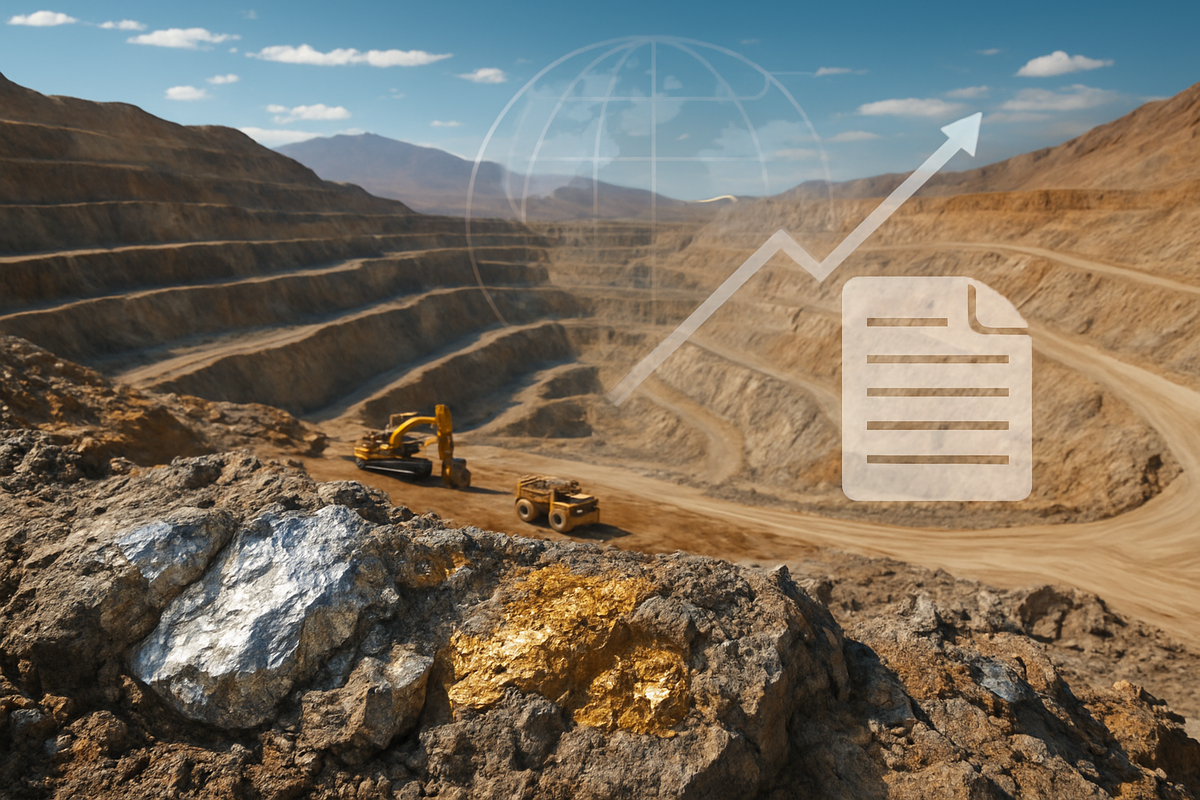
AbraSilver Resource Corp. (TSX.V: ABRA, OTCQB: ABBRF) has taken a pivotal step towards solidifying the future of its Diablillos silver-gold project in Argentina, formally submitting an application on November 21, 2025, for inclusion under the nation's newly implemented Large Investment Incentive Regime (RIGI). This strategic move, coming just days before our current date, positions Diablillos to potentially unlock significant fiscal benefits and accelerate its development trajectory. The pursuit of RIGI backing is not merely a corporate maneuver but a critical development that could profoundly enhance the project's economics, de-risk a substantial investment, and send a strong signal of renewed investment confidence in Argentina's burgeoning mining sector.
The successful integration of Diablillos into the RIGI framework could mark a turning point for both AbraSilver and Argentina's broader mining ambitions. With global demand for precious metals showing resilience and the industrial appetite for silver growing, a de-risked and accelerated Diablillos project has the potential to become a significant contributor to future global silver and gold supply, influencing market dynamics for years to come.
Detailed Coverage of a Strategic Application
The application for RIGI inclusion underscores the ambitious scale of the Diablillos project, which represents a substantial investment commitment of USD $544 million. Located strategically within the mining-friendly Salta and Catamarca provinces – both of which have opted into the RIGI framework – the project is a prime candidate for the regime's benefits. The RIGI framework itself is a cornerstone of Argentina's efforts to attract and expedite major development projects, offering a compelling package of long-term fiscal stability agreements, alongside a competitive array of tax, customs, and foreign-exchange advantages for qualifying ventures. To be eligible, projects must entail a minimum investment exceeding USD $200 million, a threshold Diablillos comfortably surpasses.
AbraSilver's move on November 21, 2025, is the culmination of extensive planning and engagement with Argentine authorities. The company's updated Pre-Feasibility Study already incorporates the anticipated impact of RIGI, projecting a significant reduction in total taxes, royalties, and export duties compared to earlier estimates, highlighting the proactive approach taken by the company. Key players in this unfolding narrative include AbraSilver's management, particularly President and CEO John Miniotis, who views the RIGI application as a major de-risking milestone. The Argentine federal government, alongside the provincial governments of Salta and Catamarca, are also central stakeholders, as their commitment to the RIGI framework is crucial for its success and the attraction of foreign direct investment.
Initial market reactions, while still unfolding given the recency of the application, are expected to be largely positive. The prospect of 'transformative benefits' and accelerated development, with a decision on RIGI approval anticipated in early 2026, suggests a significant boost to investor confidence in AbraSilver. The hundreds of millions of dollars in projected tax and fiscal benefits, including 30-year fiscal stability guarantees and reduced tax burdens, are designed to significantly improve the internal rates of return for major projects like Diablillos, making it a more attractive proposition for potential investors and partners. This development signals a potentially brighter future for large-scale mining investments in Argentina, offering a more predictable and stable operating environment.
Companies Poised to Win or Lose
The potential approval of AbraSilver's (TSX.V: ABRA, OTCQB: ABBRF) RIGI application for Diablillos is poised to create a distinct set of winners and losers within the global and regional mining landscape. AbraSilver itself stands as the most direct and significant beneficiary. RIGI backing would fundamentally de-risk the Diablillos project, translating into hundreds of millions of dollars in tax and fiscal benefits, including a reduced corporate tax rate from 35% to 25%, and crucial 30-year regulatory stability concerning tax, customs, and foreign exchange. This dramatically improves the project's after-tax Net Present Value (NPV) and Internal Rate of Return (IRR), making it exceptionally attractive for financing and accelerating its path to a construction decision, potentially as early as 2026.
Beyond AbraSilver, other large-scale silver and gold miners with advanced exploration or development projects in Argentina that meet the RIGI's minimum investment threshold of USD $200 million are also strong candidates to benefit. The successful inclusion of Diablillos under RIGI serves as a powerful precedent, signaling to the market Argentina's serious commitment to fostering mining investment. This could encourage companies like Patagonia Gold Corp. (TSX.V: PGDC), which focuses on gold and silver projects in southern Argentina, to explore RIGI for their larger prospects, benefiting from improved fiscal and regulatory conditions. Existing producers such as Hochschild Mining PLC (LSE: HOC), Pan American Silver Corp. (TSX: PAAS, NASDAQ: PAAS), and Fortuna Silver Mines Inc. (TSX: FVI, NYSE: FSM), already operating in Argentina, could also see an improved and de-risked operating environment, potentially encouraging expansions or new exploration initiatives and boosting overall investor confidence in the region. Furthermore, EMX Royalty Corp. (NYSE: EMX), which holds a 1% Net Smelter Return (NSR) royalty on the Diablillos project, is a clear winner, as accelerated development and production will directly translate into future royalty revenues.
Conversely, smaller exploration companies without large-scale projects, or those with potential deposits below the RIGI investment threshold, might face increased challenges in attracting capital. Investors, drawn by the enhanced economics and de-risked nature of RIGI-backed projects, may divert funding away from smaller, higher-risk ventures that do not qualify for the same incentives. Similarly, projects with less competitive economics that cannot secure RIGI benefits may appear comparatively less attractive. While Salta and Catamarca, where Diablillos is located, have embraced RIGI, companies operating in provinces that do not fully adhere to the framework could also find themselves at a disadvantage, facing a less favorable investment climate compared to RIGI-qualified projects.
Wider Significance and Industry Impact
AbraSilver's (TSX.V: ABRA) strategic pursuit of RIGI backing for its Diablillos project is far more than a company-specific development; it serves as a critical bellwether for Argentina's ambition to become a major player in the global mining sector and reflects several overarching industry trends. Firstly, the move aligns with the increasing global demand for both precious and critical minerals. Silver, in particular, is experiencing surging industrial demand driven by solar panels, electric vehicles, and electronics, with projections indicating significant annual consumption by 2030. Alongside this, geopolitical uncertainties continue to fuel safe-haven demand for gold and silver, making projects like Diablillos strategically important for future supply.
This development also underscores a broader industry trend towards de-risking and seeking investment certainty. Mining companies are increasingly prioritizing jurisdictions that offer regulatory stability and attractive investment climates for their capital-intensive, long-term ventures. Argentina's RIGI directly addresses this by promising 30 years of stability in tax, customs, and foreign exchange matters, aiming to shield investments from future legislative changes. This level of long-term predictability is a powerful draw for capital, potentially positioning Argentina as a more competitive destination compared to some neighboring nations that have faced fluctuating fiscal burdens or increased mining royalties.
The RIGI framework itself represents a significant policy shift, designed to overcome Argentina's historical economic volatility and inconsistent policy environment. Its comprehensive incentives, including a reduced corporate income tax rate, exemption from import duties, and greater access to foreign exchange, along with a mechanism for international arbitration, aim to provide an unprecedented level of certainty. This federal framework, contingent on provincial approval (which Salta and Catamarca have provided), also highlights the complex coordination required within Argentina's federal structure. Historically, Argentina has struggled to fully realize its mineral potential despite rich geological endowments. The RIGI, with its robust stability guarantees and investor protections, represents an innovative approach to learning from past challenges and drawing lessons from other successful mining jurisdictions in Latin America, aiming to reverse a trend of resource nationalism seen elsewhere and prioritize foreign investment attraction.
What Comes Next for Diablillos and the Market
The immediate future for AbraSilver's (TSX.V: ABRA) Diablillos project hinges on the anticipated RIGI approval, with a decision expected in early 2026. A positive outcome would be transformative, significantly boosting project economics and investment certainty. Following this, the company aims to finalize its Definitive Feasibility Study (DFS) in the first half of 2026, which would then pave the way for a construction decision later that year. With over C$42 million in cash and no debt, AbraSilver is well-positioned to advance the DFS without immediate dilution, and early works could even commence before a final construction go-ahead. Production is currently projected to begin in the third quarter of 2029, a timeline that would see Diablillos rapidly become a significant player in the global silver market.
In the long term, RIGI approval provides Diablillos with an invaluable 30 years of fiscal stability, crucial for sustained production and potential expansions beyond its initial 14-year mine life. Strategic pivots could include optimizing power sources, potentially connecting to the national grid to reduce costs and environmental footprint, and exploring expansion opportunities beyond the initial 9,000 tonnes per day throughput. Continued exploration in areas like JAC Extension and Sombra also holds the promise of further expanding the already substantial mineral resource base. The market opportunities are considerable, driven by a bullish outlook for silver and gold prices, with some analysts forecasting silver to reach $40-$56 per ounce and gold potentially touching $3000-$4000 per ounce in 2025-2026. This favorable price environment, coupled with growing industrial demand for silver in green technologies, provides a strong tailwind for the project.
However, challenges persist. Argentina's macroeconomic instability, despite RIGI's protections, could still influence investor sentiment. Regulatory complexities arising from provincial autonomy, execution risks inherent in large-scale construction, and the perennial volatility of commodity prices also demand careful navigation. The best-case scenario sees swift RIGI approval, robust financing, and a rapid path to production amid strong commodity prices, establishing Diablillos as a top-tier global silver producer. The most likely scenario involves RIGI approval in early 2026, leading to a construction decision in late 2026, and production by 2029, with the project becoming a significant economic driver for the region. A worst-case scenario would involve delays in RIGI approval, escalating macroeconomic challenges, or a significant downturn in precious metals prices, leading to project deferrals or re-evaluations. Regardless of the scenario, Diablillos' anticipated annual production of 7.6 million ounces of silver and 72,000 ounces of gold would represent a substantial addition to global supply, particularly for silver, solidifying Argentina's emerging role in critical mineral supply chains.
Comprehensive Wrap-up
AbraSilver's (TSX.V: ABRA) pursuit of RIGI backing for its Diablillos project is a landmark event for the company and a significant indicator of Argentina's evolving position in the global mining landscape. The formal application, submitted on November 21, 2025, sets the stage for a potentially transformative period, promising enhanced project economics, accelerated development, and long-term fiscal stability. This move highlights Argentina's proactive efforts to attract substantial foreign direct investment into its rich mineral resources, positioning the nation as a more competitive and predictable mining jurisdiction.
Moving forward, the market will keenly watch for the RIGI approval decision in early 2026, which will be the primary catalyst for the project's next phases. A positive outcome is expected to de-risk the USD $544 million investment, pave the way for a construction decision in late 2026, and ultimately lead to Diablillos becoming one of the world's top primary silver mines by 2029. The project's substantial anticipated output of silver and gold will contribute significantly to global supply, particularly for silver, amidst rising industrial demand and sustained safe-haven interest.
Investors should monitor AbraSilver's progress with the RIGI application, the finalization of the DFS, and any developments in the broader Argentine macroeconomic and political environment. The success of Diablillos under RIGI could set a powerful precedent, encouraging further large-scale mining investments in Argentina and reshaping the competitive dynamics within the precious metals sector. This event underscores a broader shift towards jurisdictions offering greater stability and incentives, making Argentina an increasingly important country to watch in the global quest for critical minerals.
This content is intended for informational purposes only and is not financial advice






